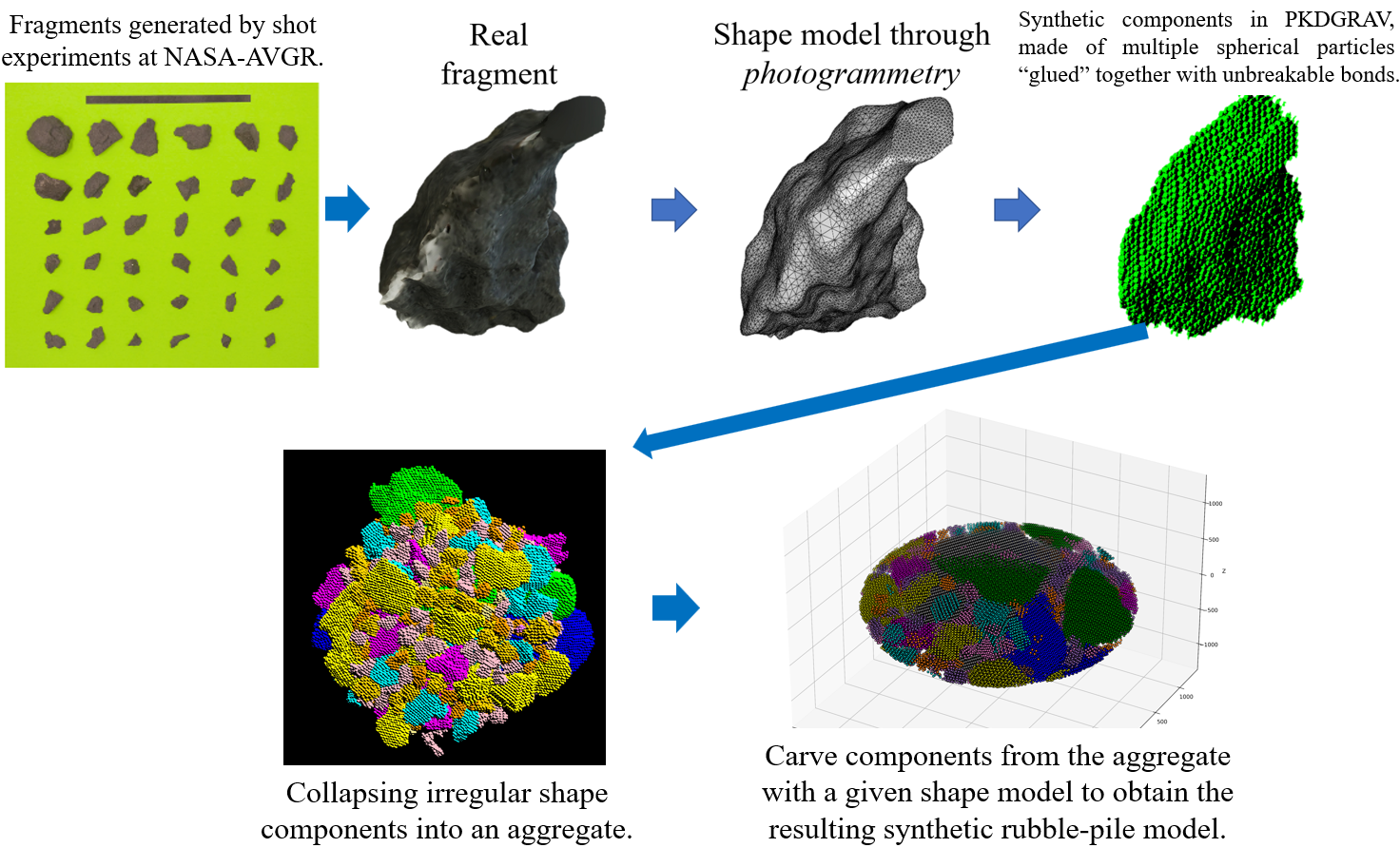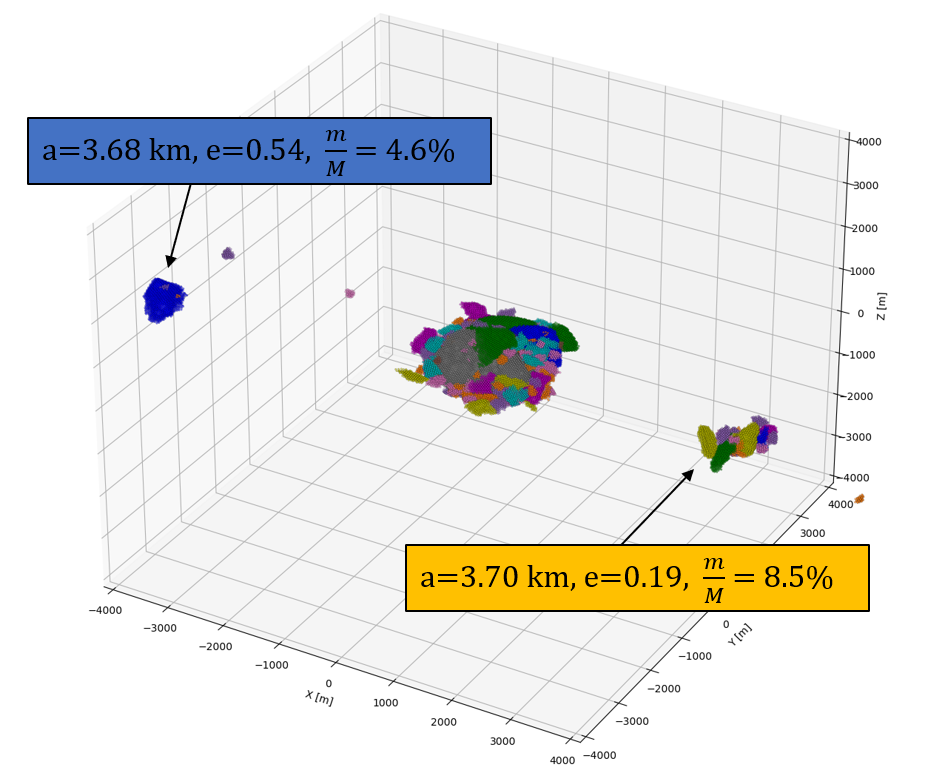Formation of binary asteroids via abrupt spin-up events.
- 1University Institute of Physics Applied to Sciences and Technologies, University of Alicante, Alicante, Spain.
- 2Department of Physics, Systems Engineering and Signal Theory, University of Alicante, Alicante, Spain.
- 3Planetary Science Institute, Tucson, AZ, USA.
- 4Astronomical Observatory Institute, Faculty of Physics, Adam Mickiewicz University, Poznan, Poland.
- 5Astronomy Dept., University of Maryland, College Park, MD, USA.
Introduction:
The evolution of rotation rates of small asteroids is subjected to mechanisms including (1) The Yarkovsky-O'Keefe-Radzievskii-Paddack (YORP) effect [1]: a thermophysical process that arises from the anisotropic thermal re-radiation of absorbed sunlight from a non-axially symmetric surface, resulting in a net torque that can secularly modify the bulk rotation rate. (2) Off-spin-axis collisions by a small projectile [2]: such collisions can change the spin state of an asteroid through the exchange between the projectile orbital angular momentum and the impacted body rotational angular momentum. (3) Planet/star close encounters: asteroids may experience close encounters with planets or their parent star, resulting in tidal forces that change their rotation state [3]. The relative significance of each mechanism depends on the interplay between the sizes, shapes, compositions, structures, and geometries of the interactions.
It has been proposed that the YORP effect may gently spin up small asteroids close to or beyond their breakup limit, assuming the effect is constant and unaltered with time by bulk deformation or spin orientation changes. This will cause gradual mass shedding from their surface, which leads to the formation of satellites [4, 5]. Alternatively, a single strong collisional event or strong tidal encounter may abruptly spin up the body well beyond the breakup limit, causing sudden fission. The significant amount of mass detached from the original body can be efficient at forming satellites. This process has not been thoroughly investigated with realistic asteroid structures, prompting the present numerical study of sudden spin-up events as a mechanism for forming binary asteroids.
Method:
Many studies usually use spherical components to simulate rubble-pile asteroids, in mono- or poly-dispersed distribution. The possible drawbacks are, for example, it prevents a suitable packing fraction in a real aggregate and overlooks the fact that real angular particles have larger friction forces than rounded particles. Therefore, we developed a pipeline called “SHattering EXperiments to Synthetic Shapes through PhotogrammetrY” (hereafter SHEXSSPY) to better reproduce the realistic shapes and mass distribution of internal components using real fragments from shattering experiments [6] (see Fig. 1 for the illustration of the pipeline). Using SHEXSSPY, asteroids are modelled as gravitational aggregates with realistic components. The sudden spin-up events can then be simulated with an updated SSDEM implementation of the PKDGRAV N-body gravity code for the handling of non-spherical components [7, 8, 9, 10].

Fig. 1. Illustration of the SHEXSSPY pipeline.
Results:
We find that relatively large fragments and clumps can detach from the original body and potentially evolve into a binary system (Fig. 2), asteroid pair, contact binary, or simply be disrupted, depending on the spin-up conditions. A significant proportion of the internal structure of the satellite formed through the fission event may come from material well beneath the surface of the primary. This may be different from the YORP-induced binary formation mechanism, where the satellites are mainly formed by material from the surface of the primary [4].

Fig. 2. Satellites formed in this study. The mass ratio between each satellite and the primary, the semimajor axis, and eccentricity of the satellite’s orbit are shown in the plot.
Acknowledgments:
P-YL, ACB, and PGB acknowledge funding by the NEO-MAPP project through grant agreement 870377, in the frame of the EC H2020-SPACE-2018-2020 / H2020-SPACE-2019. ACB and PBL acknowledge funding by the Ministerio de Ciencia e Innovación (PGC 2018) RTI2018-099464-B-I00. P-YL acknowledges funding from the ESA OSIP programme (4000136043/21/NL/GLC/my). LMP acknowledges the CIAPOS/2022/066 postdoctoral grant Generalitat Valenciana (European Social Fund). PB acknowledges the María Zambrano 2021-2023 retraining plan (ZAMBRANO22-04). JCM acknowledges the NASA FINESST grant No. 80NSSC20K1392. JVD acknowledges the NASA FINESST Award No. 80NSSC21K1531.
References:
[1] Rubincam, D., 2000, Icarus 148, 2–11.
[2] Marzari, F., Rossi, A., Scheeres, D. J., 2011, Icarus 214, 622–631.
[3] Scheeres, D. J., Marzari, F., Rossi, A., 2004, Icarus 170, 312.
[4] Walsh, K.J., Richardson, D.C., Michel, P., 2008. Nature 454, 188–191.
[5] Walsh, K.J., Richardson, D.C., Michel, P., 2012. Icarus 220, 514–529.
[6] Durda, D. D. et al., 2015. Planetary and Space Science 107, 77-83.
[7] Richardson, D. C. et al., 2000, Icarus 143, 45–59.
[8] Stadel, J. G. 2001, Ph.D. Thesis, 3657.
[9] Schwartz, S. R. et al. 2012, Granular Matter 14, 363–380.
[10] Marohnic J. C., et al. 2023, PSJ 4, 245.
How to cite: Liu, P.-Y., Campo Bagatin, A., Schwartz, S. R., M. Parro, L., Bartczak, P., Benavidez, P. G., DeMartini, J. V., Marohnic, J. C., and Richardson, D. C.: Formation of binary asteroids via abrupt spin-up events., Europlanet Science Congress 2024, Berlin, Germany, 8–13 Sep 2024, EPSC2024-110, https://doi.org/10.5194/epsc2024-110, 2024.